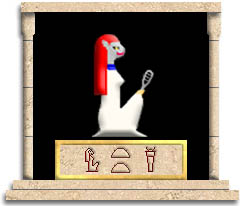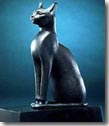| |
||||||

|
|
|||||
Translation -- "Devouring Lady" |
||||||
|
||||||
| During the 6th Dynasty she became
a patron-goddess of Lower Egypt, and thereafter was often paired with
Hathor as a patron-goddess of Upper Egypt. |
||||||
Over time, Bast's image metamorphosed to become more similar to that of Hathor. Eventually, in the Greek period, she would be equated with the virgin huntress Artemis and considered the protectress of children and pregnant mothers and musicians. She became a goddess of all sorts of excess, especially sexual excess. However, Bast's original visage did not include the "cat-as-sex-symbol" archetype. Nevertheless, the goddess' annual festival was one of the grandest
in Egypt. It was popular with religious pilgrims who went to Bubastis
by the tens, even hundreds of thousands. Herodotus describes a scene
of vast revelry and licentousness. |
 |
|||||
A play on words in Bast's name resulted in her being equated in Greco-Roman times with the "soul of Isis" (ba-Aset), probably in keeping with Isis's gradual syncretism into the Roman "Isis of Ten Thousand Names". Bast's name comes from bas, "to devour", with the feminine ending. The Valley Temple of the Pyramid of Khafre next to the Sphinx at Giza had a "Portal of Bast" as well as statues of Bast in the company of the king.
|
||||||